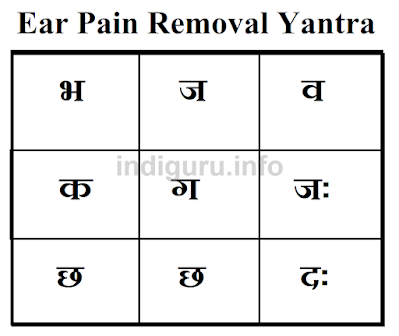In this article, I have written about three very useful Hindu Healing Yantras to remove gas from the stomach and get relief from migraine and ear pain. As per Hindu Texts on Yantra Shastra, these are all traditional Indian Yantras, which are said to possess supernatural healing powers.
Special kinds of worship or any ritual or the chanting of Mantras or Stotras have not been given for the use of these Healing Yantras and according to the Tantric Scriptures, they should only be used as described in this article.
Yantra to Remove Gas from the Body: This Yantra has the magical power to remove gas from the body and get instant relief from the pain and discomfort, which is experienced due to excess accumulation of gas in the body, especially the stomach.
The Sadhak should write this Yantra on a Bhojpatra with Kesar or Chandana and then take a small Thali filled with drinking water and go in front of the Sun and wash it in the Thali and consume the water. This Vidhi should be done on any Sunday.

Ear Pain Removal Yantra: Writing this Healing Yantra on Bhojpatra or white paper with ink and tying it with a thread around the ear removes ear pain or any other problem related to the ears.
Special kinds of worship or any ritual or the chanting of Mantras or Stotras have not been given for the use of these Healing Yantras and according to the Tantric Scriptures, they should only be used as described in this article.
Yantra to Remove Gas from the Body: This Yantra has the magical power to remove gas from the body and get instant relief from the pain and discomfort, which is experienced due to excess accumulation of gas in the body, especially the stomach.
The Sadhak should write this Yantra on a Bhojpatra with Kesar or Chandana and then take a small Thali filled with drinking water and go in front of the Sun and wash it in the Thali and consume the water. This Vidhi should be done on any Sunday.
Yantra to Remove Migraine: This Yantra has been attributed to the supernatural power to remove migraines and headaches. This Yantra should be drawn on a Bhojpatra or white paper and tied with a thread around the head to get fast relief from migraines and headaches.

Ear Pain Removal Yantra: Writing this Healing Yantra on Bhojpatra or white paper with ink and tying it with a thread around the ear removes ear pain or any other problem related to the ears.
Please Note: Information about these Indian Healing Yantras has been only given to share knowledge about ancient Hindu Healing Practices and if any person wishes to practice the same, he can do so along with his medical treatment and medicines.


Comments
Post a Comment